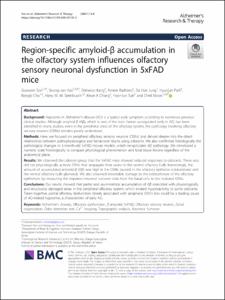Region-specific amyloid-β accumulation in the olfactory system influences olfactory sensory neuronal dysfunction in 5xFAD mice
- Title
- Region-specific amyloid-β accumulation in the olfactory system influences olfactory sensory neuronal dysfunction in 5xFAD mice
- Author(s)
- Son, Gowoon ; Yoo, Seung Jun ; Kang, Shinwoo ; Rasheed, Ameer Abu Bakr ; Jung, Da Hae ; Park, Hyunjun ; Cho, Bongki ; Steinbusch, Harry W. M. ; Chang, Keun-A ; Suh, Yoo-Hun ; Moon, Cheil
- DGIST Authors
- Son, Gowoon ; Yoo, Seung Jun ; Kang, Shinwoo ; Rasheed, Ameer Abu Bakr ; Jung, Da Hae ; Park, Hyunjun ; Cho, Bongki ; Steinbusch, Harry W. M. ; Chang, Keun-A ; Suh, Yoo-Hun ; Moon, Cheil
- Issued Date
- 2021-01
- Type
- Article
- Article Type
- Article
- Author Keywords
- Alzheimer&apos ; s disease ; Olfactory dysfunction ; beta-amyloid ; 5xFAD ; Olfactory sensory neuron ; Zonal organization ; Odor detection test ; Ca2+ imaging ; Topographic analysis ; Neuronal turnover
- Keywords
- ALZHEIMERS-DISEASE ; COGNITIVE IMPAIRMENT ; PRECURSOR PROTEIN ; ALPHA-SYNUCLEIN ; EXPRESSION ; RECEPTOR ; BULB ; INVOLVEMENT ; POPULATION ; INNATE
- ISSN
- 1758-9193
- Abstract
- Background: Hyposmia in Alzheimer’s disease (AD) is a typical early symptom according to numerous previous clinical studies. Although amyloid-β (Aβ), which is one of the toxic factors upregulated early in AD, has been identified in many studies, even in the peripheral areas of the olfactory system, the pathology involving olfactory sensory neurons (OSNs) remains poorly understood. Methods: Here, we focused on peripheral olfactory sensory neurons (OSNs) and delved deeper into the direct relationship between pathophysiological and behavioral results using odorants. We also confirmed histologically the pathological changes in 3-month-old 5xFAD mouse models, which recapitulates AD pathology. We introduced a numeric scale histologically to compare physiological phenomenon and local tissue lesions regardless of the anatomical plane. Results: We observed the odorant group that the 5xFAD mice showed reduced responses to odorants. These also did not physiologically activate OSNs that propagate their axons to the ventral olfactory bulb. Interestingly, the amount of accumulated amyloid-β (Aβ) was high in the OSNs located in the olfactory epithelial ectoturbinate and the ventral olfactory bulb glomeruli. We also observed irreversible damage to the ectoturbinate of the olfactory epithelium by measuring the impaired neuronal turnover ratio from the basal cells to the matured OSNs. Conclusions: Our results showed that partial and asymmetrical accumulation of Aβ coincided with physiologically and structurally damaged areas in the peripheral olfactory system, which evoked hyporeactivity to some odorants. Taken together, partial olfactory dysfunction closely associated with peripheral OSN’s loss could be a leading cause of AD-related hyposmia, a characteristic of early AD. © 2021, The Author(s).
- Publisher
- BioMed Central
- Related Researcher
-
-
Moon, Cheil
- Research Interests Brain convergent science based on chemical senses; olfaction; 감각신경계 기반 뇌융합과학; 후각 신경계
-
- Files in This Item:
-
 기타 데이터 / 2.67 MB / Adobe PDF
download
기타 데이터 / 2.67 MB / Adobe PDF
download



